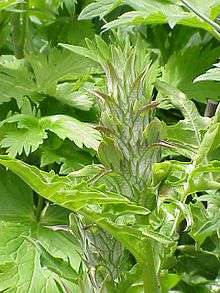Acanthoideae
Acanthoideae[2] is a subfamily of plants in the family Acanthaceae.
| Acanthoideae | |
|---|---|
| Acanthus mollis | |
 | |
| Scientific classification | |
| Kingdom: | Plantae |
| Clade: | Tracheophytes |
| Clade: | Angiosperms |
| Clade: | Eudicots |
| Clade: | Asterids |
| Order: | Lamiales |
| Family: | Acanthaceae |
| Subfamily: | Acanthoideae Eaton, 1836[1] |
| Type genus | |
| Acanthus | |
| Tribes | |
|
See text | |
Tribes and genera
Wikispecies lists the following genera in six tribes:
Acantheae
- Acanthopsis
- Acanthus
- Achyrocalyx
- Aphelandra
- Blepharis
- Crossandra
- Crossandrella
- Cynarospermum
- Cyphacanthus
- Encephalosphaera
- Geissomeria
- Holographis
- Neriacanthus
- Orophochilus
- Rhombochlamys
- Salpixantha
- Sclerochiton
- Stenandrium
- Streptosiphon
- Strobilacanthus
- Xantheranthemum
Andrographideae
- Andrographis
- Cystacanthus
- Diotacanthus
- Graphandra
- Gymnostachyum
- Haplanthodes
- Indoneesiella
- Phlogacanthus
Barlerieae
- Acanthostelma
- Acanthura
- Barleria
- Barleriola
- Borneacanthus
- Boutonia
- Chroesthes
- Crabbea
- Golaea
- Hulemacanthus
- Lasiocladus
- Lepidagathis
- Lophostachys
Justicieae
Afrofittonia - Ambongia - Ancistranthus - Angkalanthus - Anisacanthus - Anisotes - Anthacanthus - Aphanosperma - Ascotheca - Asystasia - Ballochia - Brachystephanus - Calycacanthus - Carlowrightia - Celerina - Centrilla - Cephalacanthus - Chalarothyrsus - Chamaeranthemum - Chileranthemum - Chlamydocardia - Chlamydostachya - Chorisochora - Clinacanthus - Clistax - Codonacanthus - Conocalyx - Cosmianthemum - Cyclacanthus - Cylindrosolenium - Danguya - Dasytropis - Dichazothece - Dicladanthera - Dicliptera - Ecbolium - Filetia - Fittonia - Forcipella - Glossocheilus - Graptophyllum - Gypsacanthus - Harpochilus - Henrya - Herpetacanthus - Hoverdenia - Hypoestes - Ichtyostoma - Isoglossa - Jadunia - Juruasia - Justicia - Kalbreyeriella - Kudoacanthus - Linariantha - Mackaya - Marcania - Megalochlamys - Megalostoma - Megaskepasma - Melittacanthus - Metarungia - Mexacanthus - Mirandea - Monechma - Monothecium - Odontonema - Oplonia - Oreacanthus - Pachystachys - Pelecostemon - Peristrophe - Phialacanthus - Podorungia - Poikilacanthus - Populina - Pranceacanthus - Pseuderanthemum - Pseudodicliptera - Psilanthele - Ptyssiglottis - Pulchranthus - Razisea - Rhinacanthus - Ritonia - Rungia - Ruspolia - Ruttya - Samuelssonia - Sapphoa - Schaueria - Sebastiano-Schaueria - Spathacanthus - Sphinctacanthus - Stenostephanus - Streblacanthus - Tessmanniacanthus - Tetramerium - Thyrsacanthus - Thysanostigma - Trichaulax - Trichocalyx - Xerothamnella - Yeatesia
Ruellieae
Acanthopale - Aechmanthera - Apassalus - Benoicanthus - Bravaisia - Brillantaisia - Brunoniella - Calacanthus - Clarkeasia - Dischistocalyx - Duosperma - Dyschoriste - Echinacanthus - Epiclastopelma - Eranthemum - Eremomastax - Hemigraphis - Heteradelphia - Hygrophila - Ionacanthus - Kosmosiphon - Leptosiphonium - Louteridium - Lychniothyrsus - Mellera - Mimulopsis - Pachystrobilus - Pararuellia - Petalidium - Phaulopsis - Physacanthus - Pseudoruellia - Ruellia - Ruelliopsis - Sanchezia - Satanocrater - Sautiera - Spirostigma - Stenosiphonium - Stenothyrsus - Strobilanthes - Strobilanthopsis - Suessenguthia - Trichanthera - Trichosanchezia - Zygoruellia
Whitfieldieae
- Camarotea
- Chlamydacanthus
- Forcipella
- Lankesteria
- Leandriella
- Theileamea
- Vindasia
- Whitfieldia
References
- Eaton (1836) Bot. Dict., ed. 4: 33.
- NCBI: Acanthoideae (retrieved 29 November 2017)
External links

